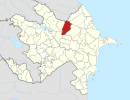Nij | |
|---|---|
Municipality | |
 Albanian-Udi Jotari Church in Nij | |
| Coordinates: 40°56′42″N 47°40′09″E / 40.94500°N 47.66917°E | |
| Country | |
| District | Qabala |
| Population | |
| • Total | 5,744 |
| Time zone | UTC+4 ( AZT) |
| • Summer ( DST) | UTC+5 ( AZT) |
| Climate | Cfa |
Nij (also known as Nidzh; Azerbaijani: Nic; Udi: НыъжӀ or НиъжӀ) is a town in the Qabala District of Azerbaijan. Located 40 kilometers south-west of the city of Qabala, Nij is one of the world's few settlements of Udi people. [2] It has a population of 5,744.
History
The Caucasian Albanian-Udi Apostolic Autocephalous Church is located in Nij.
The first Udi school and subsequently a Russian rural school were opened in Nij in 1854. From 1931 to 1933, Udis received education in their own language; in 1937 they began to receive education in the Azerbaijani language.
Ethnic Udis in Nij today are involved in a variety of vocations, which include farming, cattle breeding, rice cultivation, sericulture, horticulture, poultry farming, craftsmanship and viticulture.
Alexandre Dumas père, the French writer, in his book Voyage to the Caucasus (1859), provides detailed information about the specific economic activities, language and culture of Nij.
Controversy
In 2004, Church of Saint Elisæus in Nij was renovated as part of a project financed by Norwegian Humanitarian Enterprise. The destruction of Armenian inscriptions associated with the church during the renovations prompted a protest by Norway's ambassador to Azerbaijan, Steinar Gil. [3]
In May 2018, Foreign Minister of Armenia submitted a report to the UN General Assembly claiming that the erasing of the Armenian inscriptions at Nij was evidence that "all restoration work of Christian architectural monuments in Azerbaijan was carried out in such a way as to destroy the traces of Armenian architecture, as well as the Armenian inscriptions". [4]
Gallery
-
Mosque in Nij
References
- ^ Azərbaycan Respublikasının Dövlət Statistika Komitəsi: Qəbələ rayonu[ permanent dead link]
- ^ Mobili R. Udins: language, religion, folklore and traditions. «Azerbaijan and Azerbaijanis in the world» magazine, №2, July 2009. С.214
- ^ "Azeri church sparks political row".
- ^ Letter dated 18 May 2018 from the Chargé d’affaires a.i. of the Permanent Mission of Armenia to the United Nations addressed to the Secretary-General, page 5/21. https://undocs.org/pdf?symbol=en/A/72/876
Nij | |
|---|---|
Municipality | |
 Albanian-Udi Jotari Church in Nij | |
| Coordinates: 40°56′42″N 47°40′09″E / 40.94500°N 47.66917°E | |
| Country | |
| District | Qabala |
| Population | |
| • Total | 5,744 |
| Time zone | UTC+4 ( AZT) |
| • Summer ( DST) | UTC+5 ( AZT) |
| Climate | Cfa |
Nij (also known as Nidzh; Azerbaijani: Nic; Udi: НыъжӀ or НиъжӀ) is a town in the Qabala District of Azerbaijan. Located 40 kilometers south-west of the city of Qabala, Nij is one of the world's few settlements of Udi people. [2] It has a population of 5,744.
History
The Caucasian Albanian-Udi Apostolic Autocephalous Church is located in Nij.
The first Udi school and subsequently a Russian rural school were opened in Nij in 1854. From 1931 to 1933, Udis received education in their own language; in 1937 they began to receive education in the Azerbaijani language.
Ethnic Udis in Nij today are involved in a variety of vocations, which include farming, cattle breeding, rice cultivation, sericulture, horticulture, poultry farming, craftsmanship and viticulture.
Alexandre Dumas père, the French writer, in his book Voyage to the Caucasus (1859), provides detailed information about the specific economic activities, language and culture of Nij.
Controversy
In 2004, Church of Saint Elisæus in Nij was renovated as part of a project financed by Norwegian Humanitarian Enterprise. The destruction of Armenian inscriptions associated with the church during the renovations prompted a protest by Norway's ambassador to Azerbaijan, Steinar Gil. [3]
In May 2018, Foreign Minister of Armenia submitted a report to the UN General Assembly claiming that the erasing of the Armenian inscriptions at Nij was evidence that "all restoration work of Christian architectural monuments in Azerbaijan was carried out in such a way as to destroy the traces of Armenian architecture, as well as the Armenian inscriptions". [4]
Gallery
-
Mosque in Nij
References
- ^ Azərbaycan Respublikasının Dövlət Statistika Komitəsi: Qəbələ rayonu[ permanent dead link]
- ^ Mobili R. Udins: language, religion, folklore and traditions. «Azerbaijan and Azerbaijanis in the world» magazine, №2, July 2009. С.214
- ^ "Azeri church sparks political row".
- ^ Letter dated 18 May 2018 from the Chargé d’affaires a.i. of the Permanent Mission of Armenia to the United Nations addressed to the Secretary-General, page 5/21. https://undocs.org/pdf?symbol=en/A/72/876


